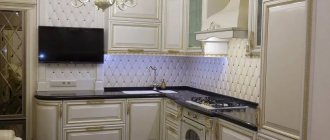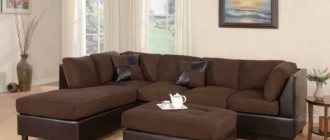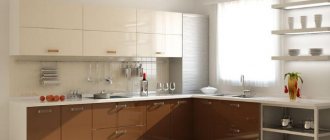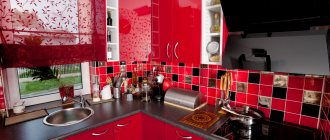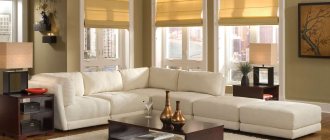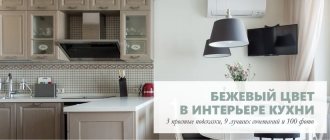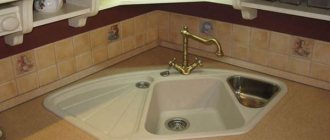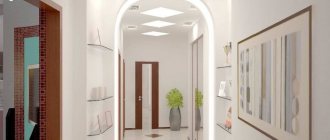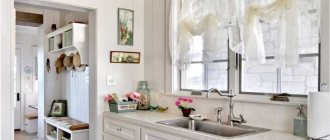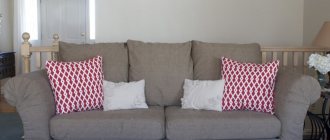Hanging module
It is necessary to consider several options for such a node:
- standard type with wall dimensions 60x60 cm;
- An option for creating wall-hung kitchen furniture by joining two straight modules.
Calculation of corner cabinets for the kitchen
Standard design of corner hinged module.
The standard hanging version (60x60 cm) has one straight back wall equal to the width of the body. To calculate this option, you must first take it in the form of a square (in plan). Then the right side (according to the picture) is divided into two parts: you need to measure 31.5 cm from the upper corner of the square - this is the standard width of the upper hanging units for the kitchen, and the remaining 275 mm are useful for determining the width of the cabinet front. This is done using the Pythagorean formula.
In this case a=b=215. The result obtained - 384 mm - gives the length of the door along the facade. And in order for it to open normally, you need to subtract 4 mm from this figure (2 on each side). There is no need to make a bevel in the upper corner of the cabinet, but if it is needed (for attaching the internal shelf), then its dimensions are calculated from the following considerations: the rear walls are taken to be equal (in this case) 471 mm, then the width of the rear panel is according to the same Pythagorean formula equal to 169 mm.
Its edges are cut at an angle of 45° to connect to the main elements using self-tapping screws.
The internal (195 mm) length of this section of the rear wall depends on the thickness of the material used.
Design of an L-shaped corner wall cabinet for the kitchen.
We offer for consideration the design of a wall-mounted kitchen drawer with increased dimensions (63x63 cm), assembled from two straight halves.
- number of facades – 2, door width – 29.6 cm;
- cabinet dimensions along the wall (without bevel) 0.5×0.5 m;
- total dimensions 63x63 cm.
To calculate such a structure, the same method is used - they consider it a square (in plan) with a side of 63 cm. Just as in the first case, measure 315 mm on the right side. The width of the facade is calculated as follows:
- 630 – 315 = 315;
- 315 -15 (wall thickness) = 300;
- 300 – 4 (gaps) = 296 mm.
The door is connected to the middle part (its length is: 315 – 15 = 300 mm) with a piano hinge. The bottom side of the box is calculated as follows:
A design option for a corner module assembled from two straight bodies.
You can assemble a corner version from two straight modules. This is done by joining them.
To do this, you need two ordinary straight cases with dimensions of 60 × 31.5 and 26.9 × 31.5 cm. This option has two doors, 264 mm each. This number is obtained by subtracting the width of the small cabinet from the length of the large cabinet:
- 584 – 315 = 269;
- 269 – 5 (gaps) = 264 mm.
This design also has a drawback - a double (in thickness) section of the blank wall at the junction of the drawers.
Now let's calculate the upper and lower horizons
Since the total size of the box (S) is 550 millimeters, the size of the horizon itself is smaller by the thickness of the side, which, as we know, is equal to the thickness of the chipboard that we will use.
To put it simply, S1=S-16 (millimeters).
This size is already enough to “hammer” it into the chipboard cutting card and cut out the necessary parts. But then these details will still need to be processed.
In our case, S1=550-16=534 (millimeters). This means that the blank for the horizons will be a square with side S1=S-16 (millimeters):
The cut at an angle is done simply. On the part, dimensions are marked equal to the width of the side (L), and on the other side - equal to the size (K) and an oblique cut is made between them.
So, we know the thickness of the side of the box, it is 300 millimeters. But the cut for the corner in which the box will be installed is made arbitrarily.
Usually it is taken no more than 100 millimeters (K). Let it be equal to 100 millimeters.
That's it, we figured it out.
Next up is the body strip
Since it is located between the horizons, and the total height of the box is 800 millimeters, the height of the body strip (h) is equal to:
h=H-32 (millimeters), where 32 mm is the thickness of two horizons, upper and lower:
But the profile of this bar itself needs to be calculated. As can be seen from the figure, the profile of the body strip is a trapezoid, and an isosceles one.
To do this, we must find out the distance AB. Here again the simple Pythagorean theorem comes to our aid.
Triangle ALV is isosceles, its sides are AL=K and LV=K, and K is equal to 100 millimeters. This means that the hypotenuse AB can be calculated as the square root of the sum of the squares of its legs:
Now, if in a trapezoid we lower the height AE onto the base of the DS, then it will be equal to the thickness of the chipboard, that is, 16 millimeters (after all, we are currently looking at the body strip from above).
And again, our triangle AED is isosceles (DE = AE = 16 mm). And if so, then the width of the body strip (DS) is equal to:
DS=√‾2К²+32 – here is the formula for calculating the width of the body strip based on the selected value (K). So, substituting our data, we get:
This means that the size of our body strip (width) will be equal to 174 millimeters. But after the body strip is cut, it needs to be “cut” in the considered projection at an angle of 45 degrees.
Corner cabinet
This type of kitchen furniture can be made in the form of joined straight modules. One of the options for this design is presented below.
Two boxes are joined through a blank wall.
It consists of two parts - a box for the sink and a cell with shelves and drawers, connected using slats through a blank front wall. The width of the cabinet is taken to be 35.5, and its length is 146 cm. It is attached to the wall of the sink using strips - this ensures normal operation of the drawers. The top of the cabinet is covered with a tabletop, the length of which above the box is calculated as follows:
1460 – 600 (width of the sink cover) = 860 mm.
The shelves on the box have a length of 20 cm. The rounding radius of their free ends is 10 cm. The width of the tabletop above the sink is 0.6 m, and above the cabinet is 0.42 m. You can calculate the length of the connection:
The most successful corner kitchen projects
When designing corner kitchens, designers make every effort to create a comfortable and beautiful room, using the most daring solutions.
The classic design of corner kitchens provides for uniform proportions, rectilinear geometry and symmetry. The dominant material is MDF, imitating various types of wood. Decor is required, giving the set idleness.
Loft style Source wcdfac.org
A modern corner kitchen designed in a loft style in dark warm tones, where comfortable furnishings are combined with vintage finishes. The unconstrained space of the room is complemented by a light floor and lighting in some areas. The furniture is made using the “artificial aging” technique.
A small kitchen with a corner sink that fits comfortably and organically into a limited space. Narrow and tall cabinets, made in light colors, visually expand the space of the room. Compact arrangement of the work area, when “everything is at hand.”
Metallic white kitchen Source wapand.sayt.im
Modern minimalistic design Source drevolub.com.ua
Full size kitchen cabinet
Its dimensions and details can be calculated based on the above-described suspended structures . You just need to increase the height of the product to 1.8 m and provide several shelves.
For the described structures, wood, chipboard, and MDF are suitable materials. When assembling the corner version, the following tools and materials are used:
- hacksaw;
- jigsaw;
- grinder with discs;
- roulette;
- metal ruler;
- hammer and nails;
- self-tapping screws;
- chipboard or MDF sheets;
- piano hinges;
- various furniture fittings.
Independent design and calculation of a kitchen cabinet is a completely doable task. Assembled with your own hands, this piece of furniture will serve you longer than any purchased product.
Kitchen furniture should be designed according to the individual preferences of the owners, according to the overall dimensions of the room. Sometimes a property owner or designer looks through a lot of options to choose the best solution. When drawing up a project, you have to take into account the dimensions of cabinets and other furniture elements. From the article we will learn what sizes of kitchen facades there are and how to choose the right doors.
Online furniture calculators
The proprietary furniture designer application program simplifies your purchasing choice as much as possible. The furniture designer allows you to independently create a project of various types of furniture in real time and find out the cost of the product.
For example, when planning to order a sliding wardrobe for the hallway, you can develop the design of your unique wardrobe, choose its internal contents and find out how much it will cost. If the cost does not suit you, you independently determine which parts can be replaced with a more economical option, and which can be discarded without compromising the ergonomics of the design.
How to independently calculate the dimensions of kitchen facades
People who want to independently design a kitchen set must be able to correctly calculate the overall dimensions of the furniture. The initial data is the length, width and height of the product. For proper functioning of the furniture, it is necessary to take into account the structural gap within 1-3 millimeters.
When calculating the width and height of the kitchen facade, the gap is subtracted from the main size, and the total value, and not on each side separately. When designing a swing facade, 3 millimeters are subtracted from the height of the product, and one value of 4 millimeters is subtracted from the width. If we take a standard case with dimensions of 760 * 420, then after calculating the dimensions we will get a value of 757 * 416 millimeters.
The requirements for the width of drawers are similar to the features of calculating hinged facades. Here a height gap of 3 millimeters is set. When designing tall cabinets with built-in household appliances, do not forget about the manufacturers' requirements regarding the operation of the products. Between the dimensions of the built-in refrigerator and the cabinet, leave 4-5 millimeters. The oven must have a gap of within 7 millimeters, which is necessary for convenient opening of the door. A special steel insert may be provided above the microwave oven, which will protect kitchen furniture from exposure to high temperatures.
Kitchens with a sink in the corner
The water and sewerage supply in most layouts is in the corner of the kitchen and most often the sink is located there.
Let's go through the nuances.
Corner sink
Everyone goes through a stage when they want to make a corner sink and cut it along the lower and upper cabinets.
The practical meaning is doubtful.
All kitchen countertops, except for expensive options made of artificial and natural stone, have a visible joint at the corner.
If you use a corner sink with wings, then there will be 2 joints, and specifically in the area of contamination.
Find and see at least 1 such kitchen in person. If you still want it, ok. But usually the desire disappears.
The upper and especially the lower corner cabinets turn out to be prohibitively deep. Below is a drawing in standard sizes. The depth of the section with the sink is 104 centimeters - more than a meter. It's inconvenient to use.
In terms of design, such a kitchen with a corner also looks like a compromise. If you want a modern interior, I would refrain. It fits better into styles with classic elements.
Regular
Placing a regular sink in a corner is standard.
A couple of tips:
- If you want a dishwasher, position it so that you can open both it and the cabinet with the trash can at the same time. In corner kitchens, it is often impossible to open both doors at the same time, which causes a lot of inconvenience.
- Do not wash next to the stove. Usually, while the food is being prepared, cleaning is going on. And standing near hot things is uncomfortable. The ideal option is a free countertop (working area) between the sink and the hob.
- Choose a faucet with a built-in faucet for filtered water and a detergent dispenser built into the sink - this improves the appearance and makes cleaning easier.
It is clear that the smaller the kitchen, the more difficult it is to implement the first 2 points, but it is already useful to think about it. I wrote about the placement of the refrigerator and lighting in articles about kitchen design 9 sq.m. and 10 sq.m.
Standard sizes of kitchen fronts
There are no strict standards regarding the size of kitchen furniture. There are special tables, but they are more of a recommendation nature. Let's take a look at the amendments regarding the standard sizes of kitchen facades:
- There are no state standards that could oblige manufacturers to produce kitchen furniture of certain dimensions.
- Despite the lack of basic standards, facade manufacturers try to adhere to the recommended unified dimensions.
- Most manufacturers try to adhere to the standard sizes of kitchen facades from MDF and other materials, especially when it comes to the width of the product.
Some manufacturers make universal furniture. Such a cabinet can be used not only in the kitchen, but also in other living spaces.
Dimensions of swing facades
The standard dimensions for swing facades in terms of height*width (in millimeters) are:
Depending on the kitchen design, the dimensions of the hinged facades may vary slightly up or down.
Dimensions of sliding facades
Standard dimensions of furniture facades for sliding kitchens in terms of height*width in millimeters:
Standard dimensions of sliding furniture elements can also be adjusted to the parameters of a particular room.
Gaps between kitchen facades
The vertical gap between adjacent furniture elements should be 3 millimeters, and 6 millimeters should be left between the table top and the top edge of the drawer. At the bottom, the cabinet is on the floor, so there is no gap.
Furniture calculations, how not to make mistakes
The calculation of any piece of furniture begins with determining the dimensions, but before that you need to measure the room and attach the dimensions to a specific point or corner. The values are transferred to a sheet of paper and they begin to develop a sketch.
It should be remembered that the dimensions of the lower base are tied to the length of the tabletop. The size of the façade of a corner cabinet in a kitchen 600*600 is determined by the required gaps; their size will depend on the geometry of the room. In a standard situation, gaps of width from 1 to 3 centimeters are left. Height discrepancies can be large, especially if the room has high ceilings.
Kitchen-living room with the letter “G”
An L-shaped kitchen is characterized by the arrangement of the furniture along perpendicular walls. There is no clear rule for choosing a color scheme, but the available lighting and the area of the room should be taken into account. Most often, kitchens with the letter L are made in the following style solutions:
- "Scandinavian";
- "loft";
- "minimalism".
Beige facade and black apron in the shape of the letter L Source goldenplaza.com.ua
Neoclassicism in the kitchen Source topdizz.com
Most often, L-shaped sets are installed in small rooms, where by any means they try to visually increase the area of free space. If such a room has household appliances (refrigerator, dishwasher), it is desirable that they be built-in. Thanks to this, plus the design of the letter L, a feeling of solidity is created, and also valuable technological space is preserved in the design.
The choice of a modernist style direction in an L-shaped kitchen-living room implies the presence of streamlined shapes, with smooth and rounded surfaces. Loft-style rooms can be furnished with simple shelves located on the walls. To add coziness to such a kitchen, it is advisable to decorate them with decorative trinkets, books or living plants.
Small corner kitchen in the shape of the letter L Source designm2.ru
Thanks to the combination of finishing materials, you can separate the living room from the kitchen. So, in the living room you can put laminate on the floor, and in the kitchen - tiles.
Lime-colored corner kitchen facade Source designmyhome.ru
Corner models
Calculation of the thickness of facades for a corner model kitchen is carried out by professional furniture makers. The dimensions of the structures in question vary, depending on their type. Despite this, corner products must be combined with straight cabinets in thickness and height.
Next, let's take a look at the features of mounted models:
- Such lockers are not used for installing equipment. There are no special requirements for capacity and strength.
- The width of corner mounted models ranges from 15-80 centimeters. The size depends on the shape of the product (triangular, trapezoidal, L-shaped).
- The depth of the standard product is 35 centimeters.
- Wall-mounted corner cabinets are fixed at a distance of 50 centimeters from the lower furniture elements. A deviation of 5 centimeters in any direction is possible.
Corner curtain walls are often used to store various kitchen utensils (spoons, forks, spatulas). Such models may have one or more doors, although there are models made on the principle of shelves.
Floor facades for the kitchen differ in the following parameters:
- When choosing the sizes of these elements, take into account the height of the gas stove.
- For a small kitchen, it is recommended to choose models with a depth of no more than 50 centimeters.
- The standard height of the products is 85 centimeters.
- The width of the cabinet ranges from 15-80 centimeters, the most popular parameter being 60 centimeters.
Floor corner facades are installed after fixing the top element. They should be located symmetrically to the upper cabinets.
When choosing corner and regular facades for the kitchen, pay special attention to their overall dimensions. These products must be correctly positioned in the room according to a pre-thought-out plan. All models must correspond to the existing design of the room and be correctly positioned relative to each other.
The front part requires utmost attention - after all, it is the quality and finishing of the doors that determines the design and “status” of the furniture. It is important not only to choose beautiful facades, but also to correctly calculate the dimensions of the cabinet doors, with uniform gaps for trouble-free opening. Errors in calculations are unacceptable, because most often it will not be possible to redo the facade, you will have to order it again. This means time and additional costs.
You can read how to calculate the fronts for a wardrobe here. This article will describe the process of calculating the sizes of swing doors and drawers for cabinet furniture (including kitchens).
General characteristics of corner kitchen layout: what to consider
It is recommended to design corner kitchens taking into account the area of the room. In small rooms, it is recommended to install bar counters that take up minimal space and are functional in use. They are good for:
- cooking;
- serving snacks;
- lunch, breakfast or dinner.
Bright kitchen Source mydizajn.ru
Kitchen with an island Source goldenplaza.com.ua
The corner layout of the kitchen room should be made taking into account the number of residents who will constantly be here. If the family is large, then in the corner kitchen it is worth installing a folding table that can be useful at lunchtime and takes up minimal space. Often, the kitchen room not only performs the function of cooking, but it can also be used for doing laundry, watching TV and reading books.
Color combination Source mydizajn.ru
When choosing a color scheme for a room, it is recommended to take into account the preferences of all family members, so that later it will be comfortable for all household members to spend time here. Neutral light shades suit almost everyone, so this color scheme is an excellent solution for large families.
White facade with wooden countertop Source gd-home.com
See also: Catalog of companies that specialize in interior redevelopment.
Minimum and maximum cabinet door size
For a swing facade, the dimensions are strictly limited by the ability of the furniture hinges to support its weight. If the load is disproportionate, the cabinet doors will inevitably sag and adjusting the hinges will only give a temporary effect. The weight of the facades is capable of tearing fasteners out of the side walls. Therefore, at the design stage it is necessary to correlate the desired dimensions of the facades with the possible ones, according to the technical characteristics of furniture hinges.
Usually, when determining the number of hinges and the size of the cabinet doors, they rely on the following table:
The maximum permissible width of the facade is about 500-600 mm. For large sizes, it is worth considering the option with two swing doors or sliding systems.
The maximum permissible height (length) of the facade is about 2200 mm. If you make the door longer, it will be inconvenient to open it.
The minimum dimensions are limited only by considerations of aesthetics and functionality. If the cabinet body is narrower than 300 mm, the hinge mounting pads should be screwed in before assembling the body itself.
Let's look at the best (second) option
First, you need to decide on the overall dimensions of S.
The width of the facade, or, for clarity, size F (Fig. No. 3) will directly depend on them.
There are reasons for this.
The module must have some height H.
So, the larger the size F, the more the geometry of the box facade will approach a square (and it should be a rectangle). And in this case, the work (opening and closing) of such a facade will create large loads on the hinges with which it is attached to the entire structure. Of course, this will not make them work better or longer.
And it will not be convenient to use such a facade, since it will require a lot of free space for its operation.
It would be impossible to put anything in a façade opening of this size.
Here are the criteria that need to be taken into account at the very beginning of designing such boxes.
As a guide, the dimensions of the corner boxes (size S) should be in the range from 500mm to 650mm.
Let the height of our box be 800 millimeters. Let's decide on its overall depth and width (in other words, its overall dimensions).
You can make the calculation in two ways: from general sizes S to size F, and vice versa.
But in practice, the first option is most often used. This is what we will use.
Let's assume that the dimensions of the box (S) will be 550 by 550 millimeters, and the width of the side of the box (L) will be equal to 300 millimeters. Let's calculate the size according to the width of the facade (F).
I would like to make a reservation right away that in most such cases, you need to know the Pythagorean theorem, which is studied either in the 5th or 6th grade of high school.
It is very simple, you can simply memorize (write it down), and there will be no problems with the calculation of such boxes.
And this theorem sounds simple: The square of the hypotenuse is equal to the sum of the squares of the legs.
Or, if we translate this theorem into our example, then our right triangle is the triangle FPP. Moreover, it is not only rectangular, but also isosceles.
For those who do not quite understand what an isosceles triangle is, I will say it more simply: this triangle has sides P equal to each other (for the reason that the sides of the box S are equal, and the width (depth) of the sides L is also the same)
Simplifying the expression, we get:
F=√‾2P² - this formula can be simply written down and safely applied in all cases that meet our conditions (and there are two of them: the dimensions P of the box are equal, and the width of the sides L is also the same). By the way, these conditions correspond to almost 99 percent of actually designed corner boxes.
I think you understand that even without knowledge of mathematics, having just one calculator, you can make calculations for corner boxes.
Well, we’ll start doing the calculations themselves in the next article.
Source
The principle of calculating the dimensions of swing doors and drawer fronts
According to the generally accepted standard, the gap between the sashes should be about 1.5-2 mm. To calculate the size of the front for the drawer, the same gaps are used. And not only so that it “looks” the same with the doors. But also because the loaded box sags a little, and the gap serves as a kind of “insurance” that the facades will not rustle against each other when they are pulled out.
For kitchen furniture, it is customary to subtract 4 mm from the dimensions of the niche. For example:
- For a cabinet with dimensions of 720x400 along the front part, the door will have dimensions of 716x396.
- For a cabinet with dimensions 720x600, two doors with dimensions 716x296 are installed.
But many people find that a gap of 4 mm is too much. Therefore, leave 3 mm, as for all other cabinet furniture. This is completely acceptable and not an error.
Nuance! When subtracting 3 mm for gaps, do not forget that you are calculating the final dimensions for the cabinet doors. If these are facades made of laminated chipboard and will then be edged with 2 mm thick PVC, then this should be taken into account. And subtract not 3 mm, but 7 (+2 mm will be added on each side, total 3+2+2). The same applies to façade options with aluminum ends and other types of edges.
To calculate the dimensions of drawer fronts, the same principle is used: subtract 1.5 mm from each side.
Simple online furniture designer and production!
it's simple
customer reviews
It turned out to be not easy to find a white pencil case with a floor-length door in Perm.
It’s easy to choose the right sizes and materials on the website, but I still needed a little specialist advice. We discussed everything and drew up a layout. And the closet is ready.
Everyone is very happy, and the assembly turned into a real adventure.
